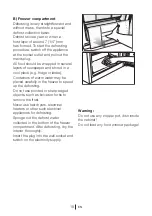
EN
8
3
Preparation
B
Please remember that the
manufacturer shall not be held liable if
the information given in the instruction
manual is not observed.
Before operating your Fridge
Freezer
Before starting to use your Fridge Freezer
check the following:
1.Is the interior of the Fridge Freezer dry
and can the air circulate freely in the
rear of it?
2.Clean the interior of the Fridge
Freezer as recommended in the
“Maintenance and cleaning” section.
3.Plug the Fridge Freezer into the wall
outlet. When the fridge door is open,
the fridge compartment interior light
will come on.
4.You will hear a noise as the
compressor starts up. The liquid and
gases sealed within the refrigeration
system may also give rise to noise,
even if the compressor is not running
and this is quite normal.
5.Front edges of the Fridge Freezer may
feel warm. This is normal. These
areas are designed to be warm to
avoid condensation
Electric connection
Connect your product to an earthed
socket which is being protected by a
fuse with the appropriate capacity.
Important:
• The connection must be in complianc
e
with national regulations.
•
The power cable plug must be easily
accessible after installation.
• The specified voltage must be equal t
o
your mains voltage.
• Extension cables and multiway plug
s
must not be used for connection.
B
A damaged power cable must be
replaced by a quali
fi
ed electrician.
Placing and Installation
1. Install your fridge freezer in a place that
allows ease of use.
2. Keep your fridge freezer in away from
heat sources, humid places and
direct sunlight.
3. There must be appropriate air
ventilation around your fridge freezer
in order to achieve an ef
fi
cient
operation. If the refrigerator is to be
placed in a recess in the wall, there
must be at least 5 cm distance with
the ceiling and at least 5 cm with
the wall. If the floor is covered with
a carpet, your product must be
elevated 2.5 cm from the floor.
4. Place your fridge freezer on an even
surface to prevent jolts.
5. Do not keep your fridge freezer in
ambient temperatures under 10°C.
WARNING: Do not locate extension
sockets or charging transformers/power
supplies or Lithium-Iron battery operated
products adjacent to the compressor
as they could overheat.
Summary of Contents for MIFF700
Page 1: ...Installation Operating Instructions Built in Fridge Freezer MIFF700 ...
Page 2: ......
Page 16: ...EN 14 ...
Page 17: ...EN 15 ...
Page 18: ...EN 16 ...
Page 25: ...57 1212 0000 AM ...











































